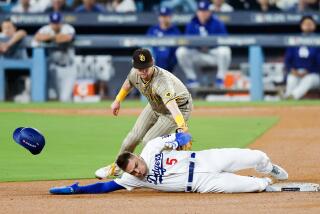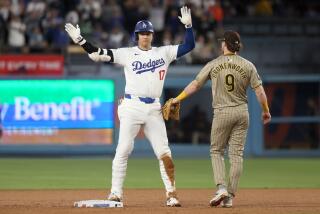Base Stealers Discover Job is Getting Tougher
Here’s a riddle: What do baseball catchers and police commissioners have in common?
Answer: Their jobs depend on keeping the theft rate down.
Lately, pilfering bases has been no laughing matter for base stealers, who are taking fewer and fewer chances and getting cut down when they do try to run.
“It’s harder and harder every year. It seems like they keep coming up with something new to stop you,” Baltimore Orioles outfielder Brady Anderson said.
The trend is not new.
Since Vince Coleman stole 109 bases for the St. Louis Cardinals in 1987, only one player, the Oakland Athletics’ Rickey Henderson, the all-time steals leader, has as many as 90 in a season.
The Florida Marlins’ Chuck Carr won last season’s National League steals crown with 58, the lowest total for an NL champion since the Cincinnati Reds’ Bobby Tolan had 57 in 1970.
None of the current leaders -- not Cincinnati’s Deion Sanders; Coleman, now with the Kansas City Royals; or two-time American League champ Kenny Lofton of the Cleveland Indians -- is on pace to steal 80 this year.
Last season, nine of the 28 teams had fewer than 100 steals. The average was 1.44 per game.
This season, through the first 782 games, major-league teams had stolen 1,060 bases, or 1.36 per game.
NL teams are averaging 1.38 with a 67 percent success rate; AL teams are attempting 1.36 with the same success rate.
One important reason for the decline of the steal is the decline of some of the stealers. Henderson and Tim Raines of the Chicago White Sox, who between them have won 15 stolen base titles, both will be 35 by season’s end, which is especially old for base stealers, and both have been hobbled with injuries the past few seasons.
Then, too, base-stealing championships are being won with fewer and fewer steals, to the point where Anderson, who stole 53 two years ago, predicts that 65 to 70 bases, not 90 or 100, will be the benchmark to shoot for in the future.
The overwhelming favorite on the list of factors keeping base stealers and wanna-bes anchored is the increasing use of the slide step by pitchers.
The quicker delivery has helped such pitchers as Kansas City’s David Cone and the Orioles’ Ben McDonald, infamous for their inability to hold runners on, speed their delivery to the plate from 1.4 or 1.5 seconds to a more manageable 1.2 or 1.3, thus keeping runners on a shorter leash.
“I’ve got to do it sometimes,” McDonald said. “Guys like Lofton, Rickey, Coleman and (Kansas City’s Brian) McRae make you aware, and it (the slide step) is an advantage. The catcher has no chance of getting some of those guys unless you use it.”
Said Anderson: “Our pitchers are fanatic about it, and it helps a lot. They might lose some control using it, but not velocity.”
There also seems to be a better brand of catcher working these days. The White Sox’s Ron Karkovice, Texas Rangers’ Ivan Rodriguez, San Francisco Giants’ Kirt Manwaring and St. Louis’ Tom Pagnozzi are all acclaimed for their ability to throw out runners.
“You got some catchers who can really throw, even if the pitchers aren’t that quick, like when Johnny Bench was playing,” said Lance Johnson of the White Sox, who stole a team-high 35 bases last year. “You (a pitcher) don’t have to be as quick when you got a guy like Karkovice or Rodriguez from Texas that’ll beat you.”
Johnson’s teammate, Mike La-Valliere, who backs up Karkovice, points to baseball’s offensive explosion as a factor, figuring “you’ve got an awful lot of guys hitting the ball out of the ballpark and you don’t really want to run into too many outs.”
For Davey Lopes, the Orioles’ first base and base-running coach, the answer to baseball’s base-running slump has little to do with slide steps or better catchers and much to do with a lack of aggressiveness.
“Just like you think when you’re hitting, you have to think when you’re on base,” said Lopes, who won stolen base titles with the Los Angeles Dodgers in 1975 and 1976.
“You have to have that mentality. I don’t think Lofton’s afraid of anybody. That’s the type of guy you have to be. (The Toronto Blue Jays’ Roberto) Alomar and Rickey are the same way. It depends on the individual.”
More to Read
Go beyond the scoreboard
Get the latest on L.A.'s teams in the daily Sports Report newsletter.
You may occasionally receive promotional content from the Los Angeles Times.










